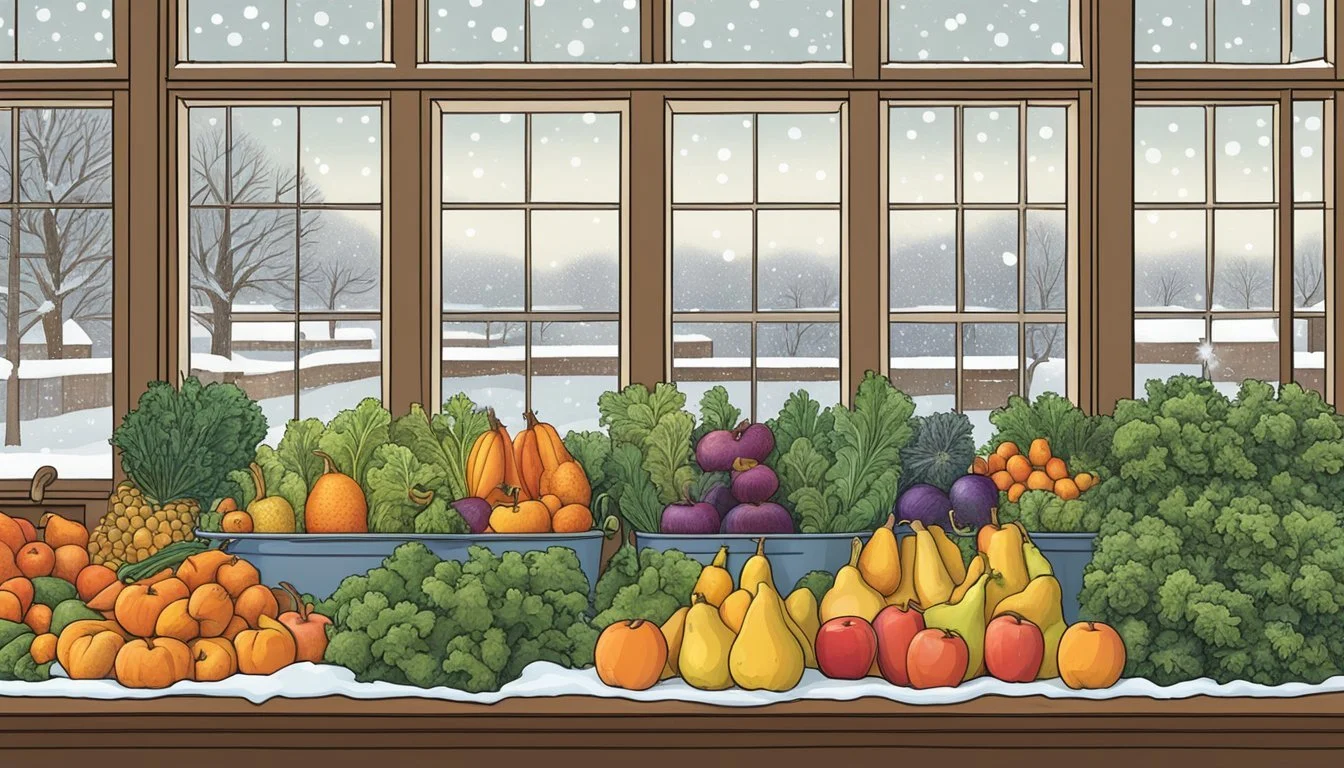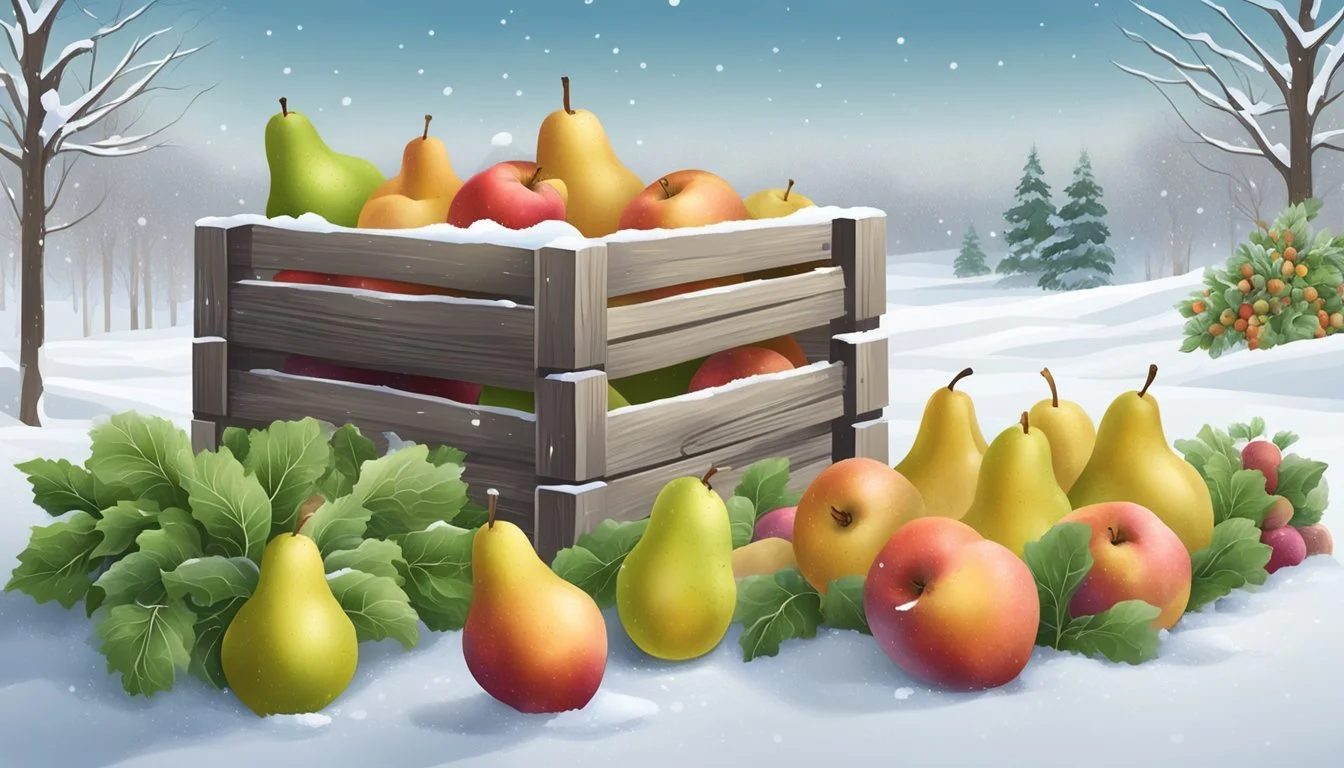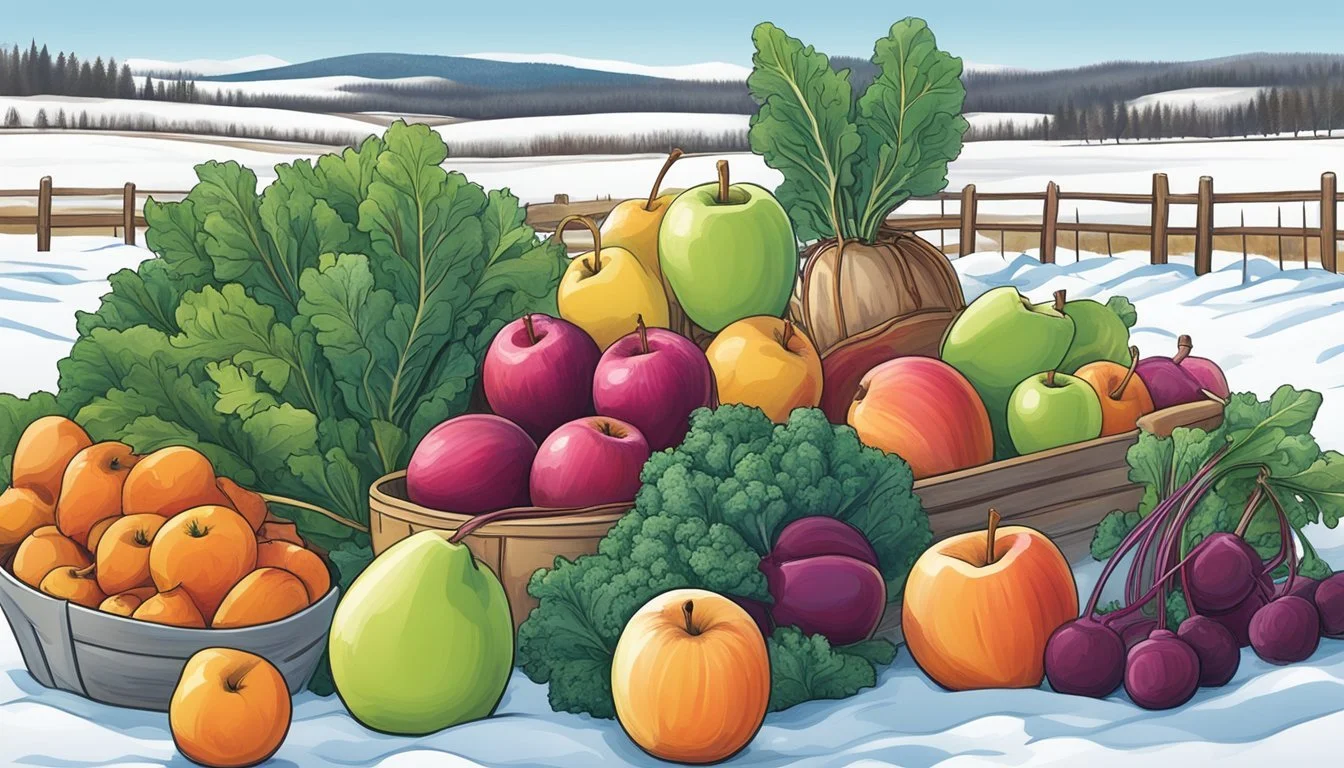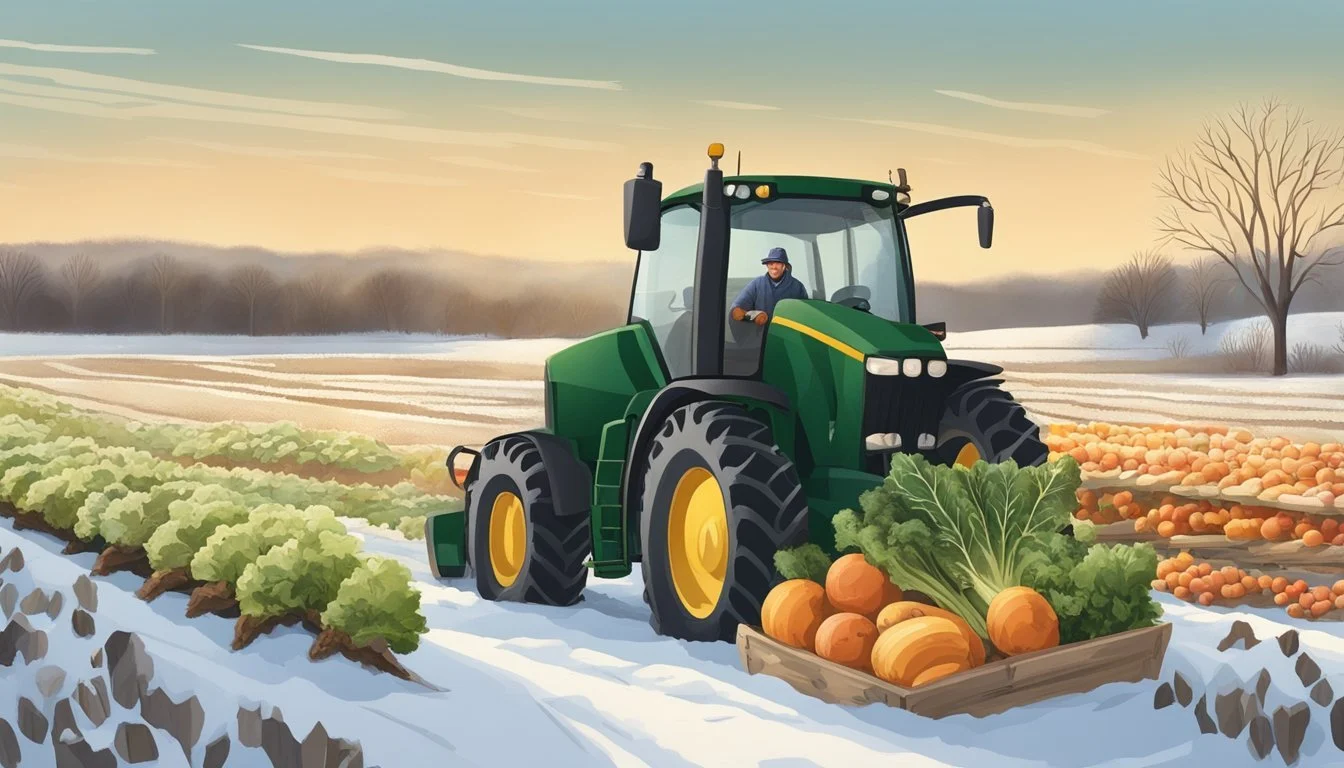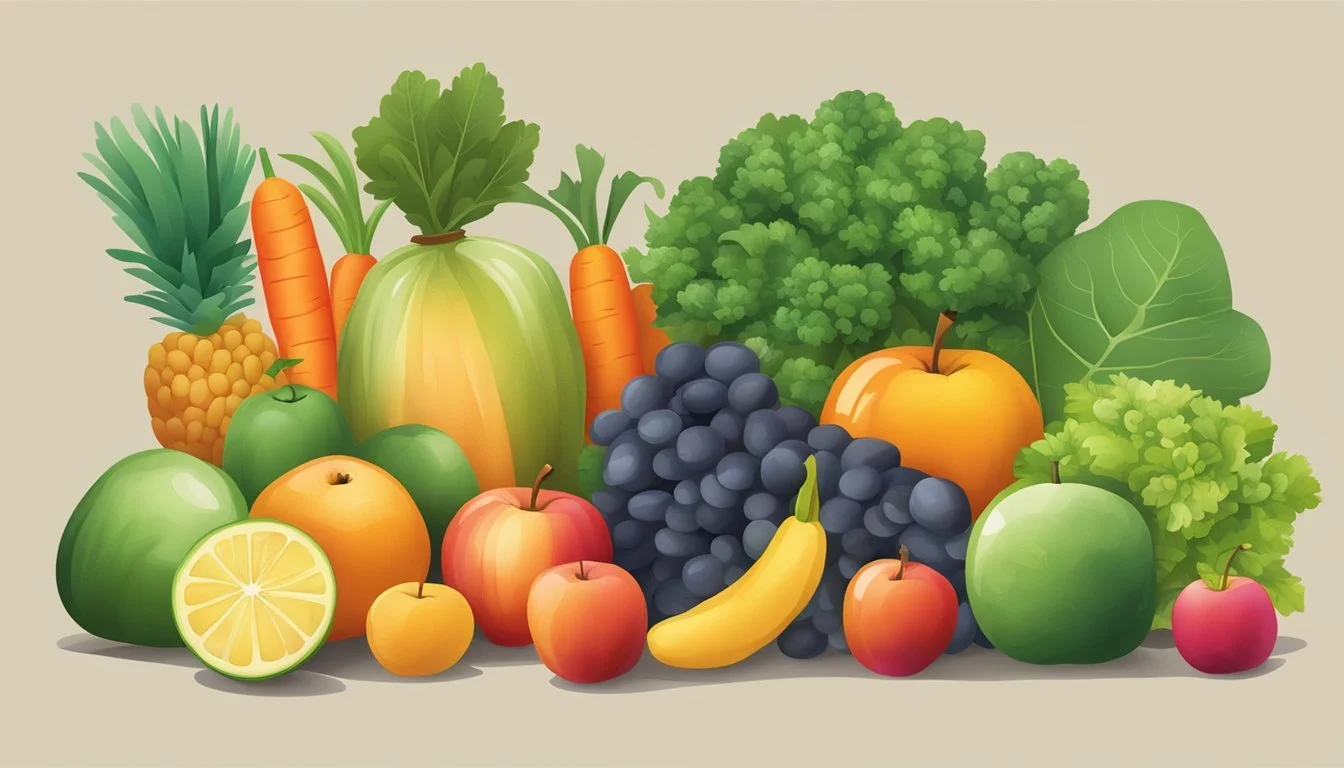Missouri Seasonal Fruit & Vegetables in January
Your Fresh Produce Guide
This Article is Part of our Missouri Seasonal Fruit & Veg Calendar
In January, the Missouri landscape is often blanketed with snow, but the state's agriculture doesn't fully hibernate. Local produce during this time leans heavily on robust, winter-hardy selections. Root vegetables and hearty greens are staples, providing residents and chefs alike with fresh, nutritious options even in the chill of winter. Seasonal eating, with an emphasis on enjoying produce at its peak freshness, is a practice that not only supports local economies but also ensures the highest quality in flavor and nutritional value.
The range of fruits available is limited during this period, yet it is still possible to find certain varieties in storage from late autumn harvests, such as apples. On the vegetable front, Missouri soil yields nutritious and versatile choices like kale, which can withstand the cooler temperatures. These resilient crops offer an abundance of culinary possibilities, from soups and stews to roasted dishes and fresh salads.
It’s a time when Missourians turn to stored, canned, and preserved goods as well to complement the fresh produce. Items like squashes and pumpkins, along with preserved fruits, become important ingredients in the local cuisine. This reliance on preserved goods illustrates a time-honored tradition of preparation and conservation that is particularly poignant in the colder months when fresh produce is less abundant.
Understanding Seasonality
Seasonality refers to the specific time of the year when fruits and vegetables reach their peak in flavor and nutrition. It is influenced by regional climate and local weather conditions, which determine the natural growing cycles of produce.
Importance of Eating Seasonally
Eating seasonally means consuming fruits and vegetables around the time they are harvested. This practice not only offers the freshest and tastiest produce but also supports local economies and reduces the environmental impact associated with long-distance transportation. Seasonal eating encourages a diverse diet as it varies throughout the year, exposing individuals to a wide range of nutrients and flavors.
Seasons and Crop Availability in Missouri
Missouri’s climate allows for a range of fruits and vegetables to grow in different seasons:
Winter: Despite the colder weather, January still offers a selection of produce. Root vegetables and some hardy greens are typical during this time.
Here is a simplified table reflecting crop availability in Missouri for January:
Vegetable Availability Sweet Potatoes In Season Winter Squash In Season Greens In Season
Fruit Availability Apples In Season
The produce available can vary by exact region within Missouri and by specific weather conditions for the year. Consumers are encouraged to consult local resources for the most accurate information regarding monthly crop availability.
Winter Produce in Missouri
During the winter months, Missouri's harvest continues to offer a range of produce, even in the chill of January. The emphasis is on hardy vegetables and stored fruits that can withstand the cold.
January Harvest
In January, Missourians can find a variety of vegetables that thrive in the state's winter conditions. Locally grown produce includes:
Root Vegetables: These are often available due to their ability to be stored after fall harvest. Common examples are:
Carrots
Sweet potatoes
Beets
Winter Squash: Varieties such as butternut, acorn, and spaghetti squash are generally still in supply, having been harvested in the fall and capable of being stored for winter use.
Leafy Greens: Some hardy greens can be grown in Missouri's winter, others can be stored; these might include:
Spinach
Kale
The fruit selection during January mainly consists of those that have been stored from fall or are hearty enough to survive the early winter months. Missourians might enjoy:
Apples: Several varieties can be kept in cold storage and enjoyed throughout the winter.
While the harvest for most fresh produce is limited during winter, certain fruits and vegetables are well-suited for January's colder temperatures and can provide freshness to the New Year diets of locals seeking seasonal foods.
Selection and Storage Tips
Proper storage is essential for maintaining the freshness and flavor of produce. Below are specific tips to ensure that winter fruits and vegetables retain their quality from the market to your table.
Storing Winter Vegetables
Winter vegetables are typically hardy and can be stored for longer periods. A cool, dark, and well-ventilated environment is ideal for storage. They should be kept at a consistent temperature to maintain their freshness. Here are specific tips for common winter vegetables:
Root Vegetables (e.g., carrots, beets): Store in a cool, humid place. They can be kept in the refrigerator in a plastic bag with holes for circulation or in a root cellar. Avoid washing them before storage as this can promote rot.
Leafy Greens (e.g., kale, collards): Store in the refrigerator in a loose plastic bag. They need slight moisture; however, too much can lead to wilting and spoilage.
Winter Squash: Store in a cool, dry place with good air circulation. They can last up to a month or more when stored properly.
Storing Winter Fruits
Winter fruits often require slightly different storage methods to ensure they stay ripe and edible. Here is how to properly store some common winter fruits:
Apples: Store in a cool place, away from other fruits. Apples emit ethylene gas, which can cause other fruits to ripen faster and potentially spoil.
Citrus Fruits (e.g., oranges, lemons): Store in a cool place with good air circulation or in the refrigerator if not consumed quickly. They do not need to be in a plastic bag.
Pears: These can be kept at room temperature until ripe and then refrigerated to slow further ripening.
For both fruits and vegetables, freezing is an option for longer preservation. Most vegetables should be blanched before freezing to preserve their texture and flavor. Fruits can typically be frozen directly, although some may benefit from being peeled or sliced, and others may need a light sugar syrup to maintain quality. Always use airtight, freezer-safe containers or bags to prevent freezer burn and preserve the quality of the food.
Preparation and Cooking Ideas
January in Missouri offers a variety of seasonal fruits and vegetables that are perfect for creating warming dishes during the colder months. Utilizing these ingredients allows one to cook dishes that are both flavorful and nourishing.
Hearty Soups and Stews
Seasonal vegetables like broccoli, cauliflower, and Romanesco make a robust foundation for comforting soups and stews. These ingredients can be combined with stock and herbs to create a nutritious meal. One may sauté cauliflower with onions and garlic before blending it into a creamy soup. For stews, adding chunks of these vegetables along with protein sources such as beef or beans and simmering slowly makes for a hearty dish.
Savory Dishes
Turning to savory dishes, spaghetti squash can substitute traditional pasta (how long does pasta last?), offering a lower-calorie and gluten-free option. It's simple to roast and then combine with a mix of sautéed winter vegetables or a hearty meat sauce for a filling meal. Another versatile vegetable, kale, can be added to a winter salad, tossed with a tangy dressing, or used in a robust salsa for added texture and nutrition.
Desserts and Jams
For desserts, citrus fruits like lemons and oranges that are available in January can be the star of the show. They can be transformed into vibrant jams without needing additional thickeners, allowing the full fruit flavor to shine through. Dessert recipes might include incorporating citrus zest or juice into cakes, or creating compotes to top yogurt or ice cream. Citrus jams pair well with toast, pastries, or as a sweet filling for layered desserts.
Health Benefits of Seasonal Produce
Eating seasonal produce provides individuals with peak nutritional value and health benefits. January's offerings in Missouri bring a variety of fruits and vegetables rich in essential nutrients.
Nutritional Advantages of Winter Produce
Winter produce in Missouri is not only fresher but often contains higher levels of important vitamins and minerals. Seasonal fruits and vegetables harvested in the colder months are naturally adapted to thrive in the winter conditions, concentrating their nutrients to survive. For example, kale and spinach, two common winter greens, are excellent sources of vitamin C, which is vital for immune system function and skin health.
Vitamin C: A strong antioxidant found in high concentrations in citrus fruits like oranges and vegetables such as Brussels sprouts (how long do brussels sprouts last?).
Health: Consuming fresh, seasonal produce can enhance overall health by providing the body with essential nutrients when they are most needed.
Nutritional: Winter months often mean a greater need for nutrients that support immune health, and seasonal vegetables like sweet potatoes are packed with beta-carotene, converting to vitamin A in the body, which is crucial for vision and immunity.
Food: Emphasizing food that is available locally and seasonally ensures that individuals are getting produce at its peak ripeness and flavor, which often means it's at its nutritional best.
In January, one not only enjoys the rich, comforting textures and flavors of winter produce but also the dense nutritional profile that comes with it.
Locally Sourced Produce
In January, Missouri markets proudly feature a selection of local produce that supports the state's agricultural community. The winter season offers various options for consumers seeking fresh and regionally grown goods.
Supporting Missouri Farms and Markets
In the heart of winter, local markets in Missouri continue to support state farms by providing residents with seasonal produce. These markets are integral to sustaining the agricultural economy and ensuring that consumers have access to fresh food.
Seasonal Produce Available in Missouri in Early January:
Chicories
Radicchio
Rapini
Salsify
Sprouts
Missouri's local produce offerings might seem limited during the colder months, but they are rich in variety and nutritional value. Shopping at these markets not only bolsters the local economy but also ensures that consumers enjoy the freshest produce picked at its seasonal peak.
Seasonal Recipes and Ideas
In Missouri, January's colder climate invites the use of hearty produce in various dishes. Hearty greens and root vegetables come into play, creating wholesome meals with deep flavors and nutrients. These recipes and ideas should inspire the use of seasonal Missouri produce.
Winter Salads
One can elevate the humble salad by incorporating kale and spinach with a zesty lemon vinaigrette. Adding roasted beets and a sprinkle of goat cheese not only brings layers of taste but also adds a warm element to these winter salads. For crunch, one might toss in some walnuts or pumpkin seeds (how long do pumpkin seeds last?).
Warm Side Dishes
Rich and flavorful side dishes, often rooted in comfort, are a staple in January. A puree of butternut squash (how long does butternut squash last?), seasoned with nutmeg (how long does nutmeg last?) and cinnamon, can serve as a warm, velvety accompaniment to any main course. Additionally, roasted carrots and sweet potatoes, drizzled with a touch of honey and sprinkled with fresh thyme, add both color and a caramelized depth to the winter table.
Seasonal Desserts
Desserts in January can harness the sweet and tart profiles of seasonal fruits. A rustic apple tart, made with locally grown apples, warms the palate with its spiced notes and buttery crust. For a lighter end to a meal, one might serve a citrus salad with a drizzle of honey and a scattering of pomegranate seeds (how long do pomegranate seeds last?), offering a refreshing contrast in both flavor and texture.
Planning for the Seasons Ahead
While January in Missouri brings a smaller variety of fresh produce, it also marks an important period for gardeners and farmers to plan for the abundance of spring and summer. The success of the upcoming seasons' harvest significantly depends on the preparations made during these colder months.
Looking Towards Spring and Summer Produce
As Missouri transitions from the cold of winter to the warmer spring months, anticipation grows for the arrival of a fresh assortment of fruits and vegetables. Planning is essential to maximize the yield of produce such as strawberries and tomatoes which begin to signal their impending bounty as early as June. Gardeners and agricultural planners meticulously schedule their planting to ensure a continuous supply throughout the warmer months.
The cultivation of summer produce like peaches, sweet corn, and a variety of berries starts well before the season arrives. This involves selecting appropriate varieties that will thrive in Missouri's zone 5 to 7 climate. Through careful planning, one can ensure the successful growth of vibrant and flavorful fruits and vegetables. Timely planting, adequate soil preparation, and pest management strategies are all part of the preparations for the summer's fruitful harvest.
By being proactive and knowledgeable about the requirements of each type of produce, growers can look forward to a rewarding spring and summer season filled with the freshest local offerings.
Fruit and Vegetable Glossary
In January, the selection of locally available produce in Missouri narrows due to the colder climate. However, there are still a variety of hardy fruits and vegetables that thrive during this time of the year. This glossary provides a list of those seasonal items.
List of Seasonal Fruits and Vegetables
Fruits:
Apples: An assortment of apples remain available, as they store well after the fall harvest.
Pears: Similar to apples, certain varieties of pears are seasonal during the winter months.
Vegetables:
Root Vegetables:
Turnips – A versatile root vegetable that can be roasted, mashed, or used in stews.
Parsnips – Sweet and pale, these are often used in similar ways to carrots.
Sweet Potatoes – Nutrient-rich and hearty, perfect for a variety of dishes.
Radicchio – A bitter chicory that's often used in winter salads.
Carrots - Still crunchy and sweet, ideal for soups or snacks.
Beets – Earthy flavor suitable for roasting or salads.
Brassicas:
Kale – A nutritious leafy green, stands up well to cold temperatures.
Brussels Sprouts – Typically harvested after the first frost, enhancing their sweetness.
Broccoli – Robust and hearty, perfect for steaming or stir-frying.
Cabbage – Can be used fresh in salads or fermented into sauerkraut (how long does sauerkraut last?).
Alliums:
Garlic – A staple in many dishes, stores well through the winter.
Leeks – Mild and versatile, they add depth to soups and casseroles.
Others:
Celery Root (Celeriac) – A knobby root vegetable with a subtle celery flavor, excellent in soups or mashed.
Collards – Hardier greens that are often braised or used in soups.
Squash (Winter Varieties) – Include varieties like acorn, butternut, and spaghetti squash.
Potatoes - Due to their good storage capabilities, various types remain available throughout the winter.



